This easy homemade New York-Style Bagel recipe is simply the best! Basic pantry ingredients transform into deliciously chewy freshly made New York bagels.
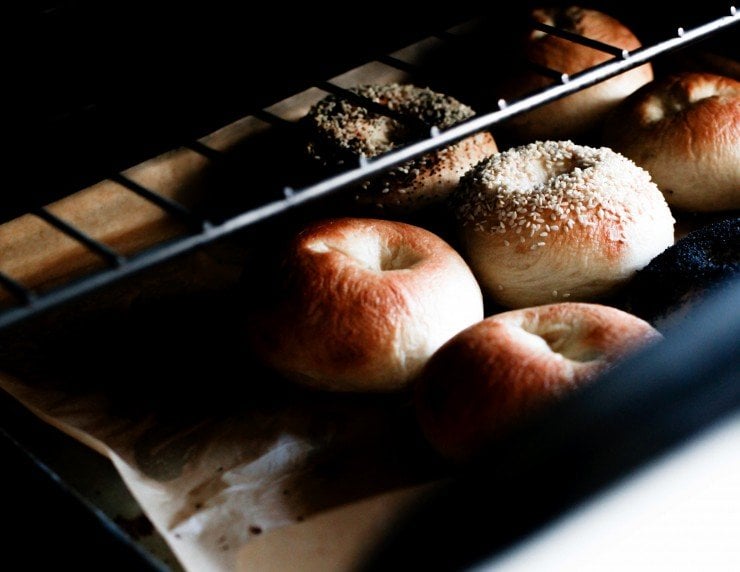
This is simply the best homemade New York-Style Bagel Recipe. After so much love (this recipe has received over 11 years worth on here!), I had to share the recipe in Hand Made Baking, and I updated this page with various photos, tons of tips, tricks, and information you’ll need to achieve the most perfect chewy homemade bagels.
This easy bagel recipe is delicious and results in perfection. It does not need as much dedication as other bagel recipes you will find on the web– you do not need to dedicate 2 days to this. It’s a same-day homemade bagel recipe that comes together in 2 hours.
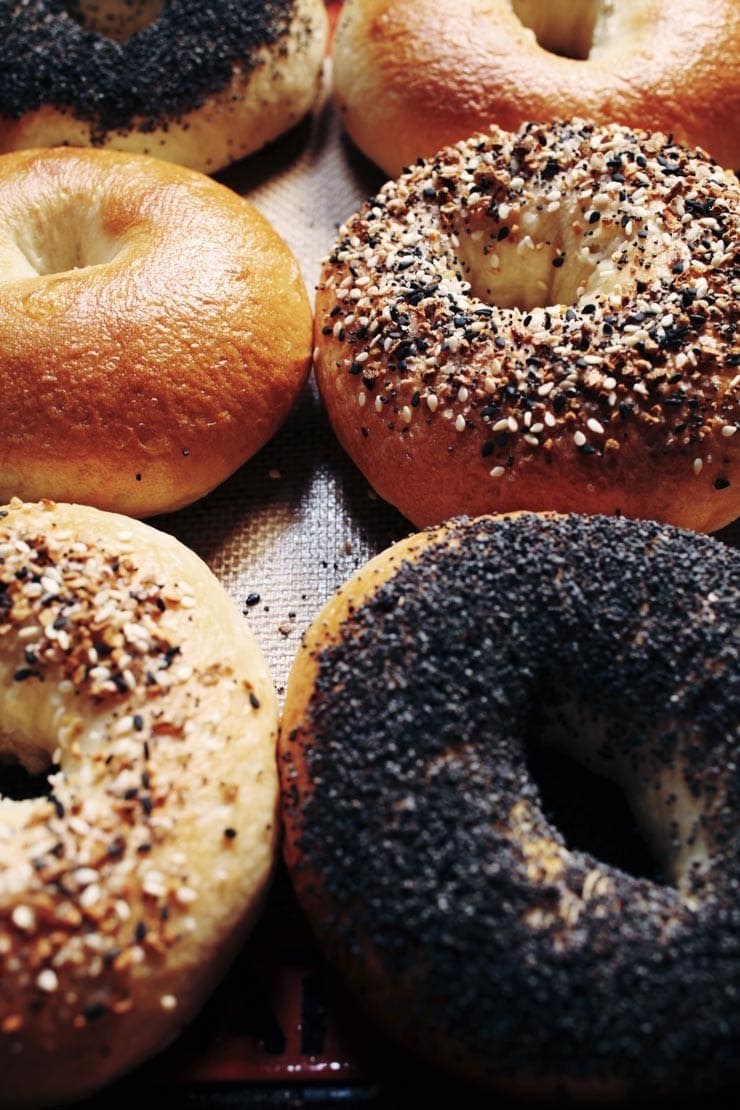
As a native New Yorker, I know there’s nothing better than a fresh bagel schmeared with cream cheese. I have a high standard when it comes to bagels and I don’t put unusual ingredients in mine.
In these bagels, you will not find any yogurt, maple-syrup, or ingredients you might not have in your pantry.
I no longer live in New York City, and I constantly crave the good old-fashioned bagels I grew up on– flavorful, modestly sweet, and chewy with soft, shiny crusts. These bagels are made the classic way: you boil them in water for a couple of minutes before you bake them. This is probably one of the most bizarre things a person can do to dough, but it just works.
This bagel recipe is a very altered adaptation of one from a cookbook, Ultimate Bread, that I borrowed over a decade ago from my aunt. It was my first introduction to homemade bagels. Over the years, this has become the best bagel recipe that I’ve ever made.
It doesn’t require unusual ingredients or require special equipment to make the recipe. These homemade chewy bagels are a treat fresh out of the oven, but when they’re toasted– oh, my! Can we just say that you’ll be making this bagel recipe time and time again?
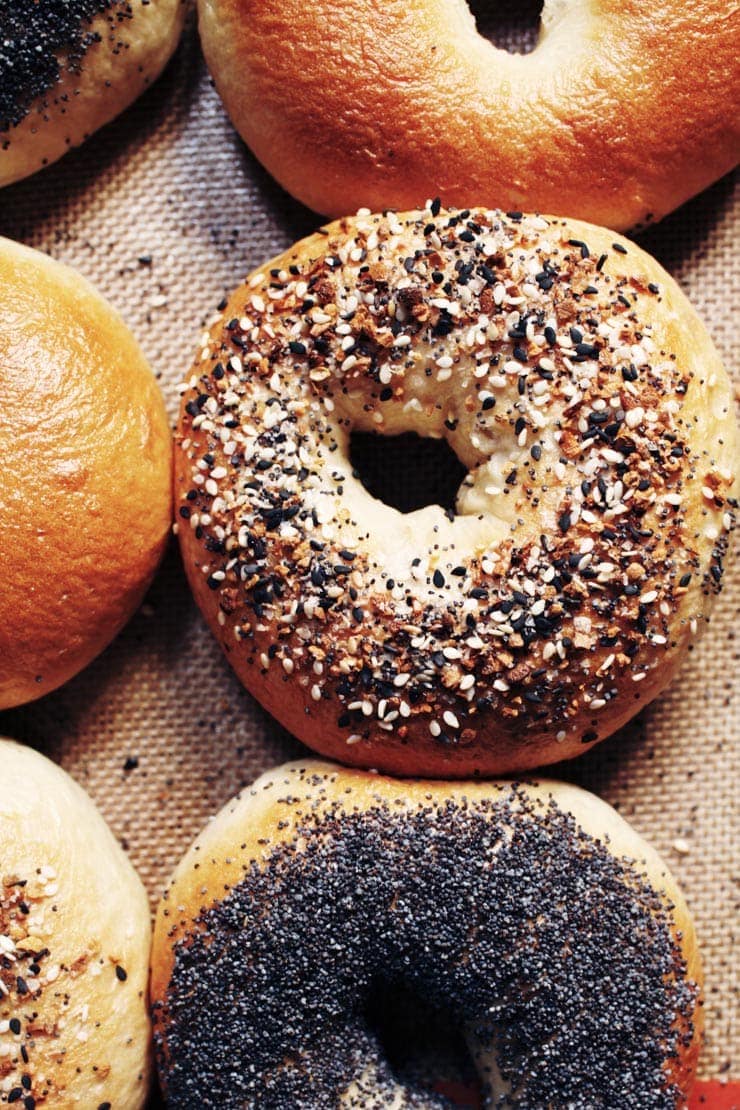
After making this New York-Style bagel recipe on your own, you will feel a sense of accomplishment and satisfaction. I know I always do! This will definitely give some competition to your local bagel shop- the recipe is that good (I mean, look at the comments!).
This homemade bagel recipe is so good that you’ll be impressed with yourself and totally satisfied after you take a nice bite out of one of these freshly made chewy bagels. So, if you mail order bagels from your favorite spot in New York City and pay $7.50 a bagel, save your money!
And if good bagels cannot be found where you live, worry no more; this recipe is infinitely adaptable, and the little bit of effort you put into making these bagels is well worth it. It’s time to get baking!
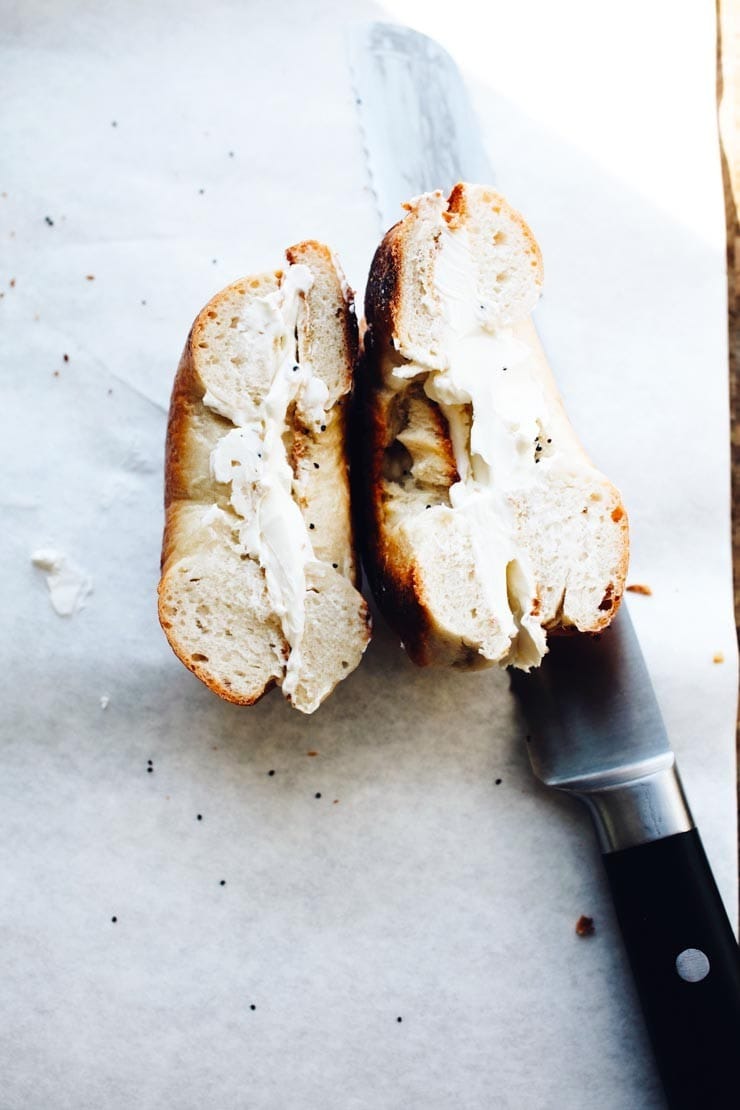
Homemade Bagel Recipe Ingredients
This homemade bagel recipe consists of four major parts– making and preparing the bagel dough, shaping and boiling the bagels, the bagel topping, and the things you’ll need to serve them with. Here’s what you’ll need:
The Bagel Dough: The Bagel Recipe Ingredients
- Granulated Sugar: This is used to slightly sweeten the bagel dough and to activate the yeast.
Feel free to use natural cane sugar here if you have it. - Active dry yeast: Yeast is used to help the bagel dough form and rise.
- Luke warm water: This needs to be between around 105ºF/ 40.5ºC and 115ºF / 46ºC; this will also help the yeast activate and bind the flour and other ingredients into a smooth, elastic bagel dough. On the rare occasion, you may need more water than listed in the recipe. The water called for in the recipe is a guide– your ultimate goal is to form a smooth bagel dough that is moist and firm.
- Bread flour: Bread flour contains a high protein content, perfect for making homemade bagels that are chewy. All-purpose flour works here too, they will be just as delicious– just not as chewy as ones made with bread flour (Read: New York-Style Bagel Recipe FAQ located below the recipe in this post for more information about flour alternatives for these homemade bagels).
- Fine-Grain Sea Salt: Salt adds the right amount of flavor to the bagels.
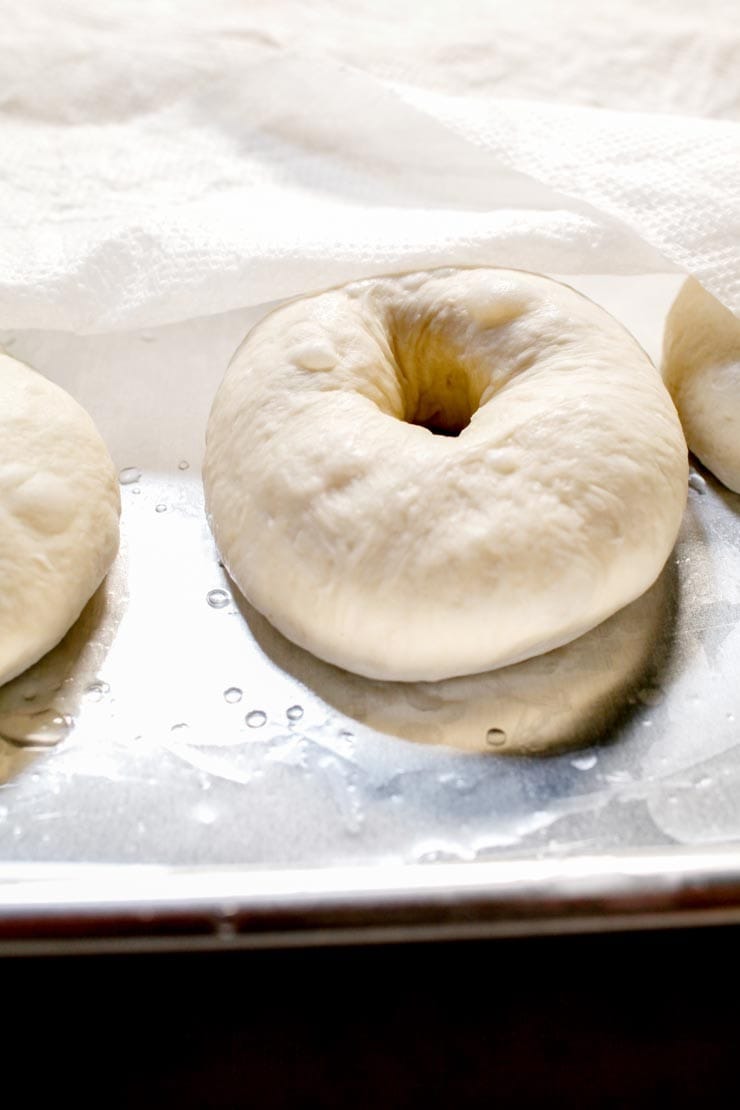
Shaping and Boiling the Bagels
There are many methods in which you can shape a bagel; there is a more traditional method that many bagel shops use– you roll the bagel dough into logs and bind the ends together.
The method used here is done by simply poking the hole in the middle of taught rounds of bagel dough. Once that is done, the bagel rings are gently stretched to about a third of the diameter of the bagel.
After a short rest, each bagel is boiled. This gives the bagels their New York-Style signature delicious, chewy, and shiny crust.
Read more: New York-Style Bagel Recipe FAQ located below the recipe section in this post.
While you can opt to flavor your poaching liquid (there’s more information about this in the FAQ section), I keep it simple here and just use water and these come out perfect every time.
The Bagel Toppings
Favorite bagel toppings vary from person to person. Depending on the day, I like a good homemade everything bagel or a poppyseed bagel. I know many people who are partial to single toppings like minced onion or coarse salt. Whatever you like, definitely customize the toppings to match your tastes.
Everything bagel seasoning, minced fresh garlic, minced fresh onion or shallot, poppy seeds, sesame seeds, caraway seeds, coarse salt, cinnamon sugar- these are just some of the many topping options you can go with to customize the taste of your bagels.
What to Serve the Bagels With
A proper New York-Style bagel always requires a schmear. What is a “schmear” you ask? It’s a generous slather of cream cheese. It’s practically a requirement, especially when these homemade bagels come out of the oven. However, there are multiple ways you can serve them– all of which I have listed within this post.
How to Make Homemade New York-Style Bagels
First, proof the yeast. Proofing basically means you’re activating the yeast. To do this, you will need to add sugar and yeast into luke warm water. After about 5 minutes, the yeast will bubble up; this indicates that the mixture is ready to stir until everything is properly dissolved.
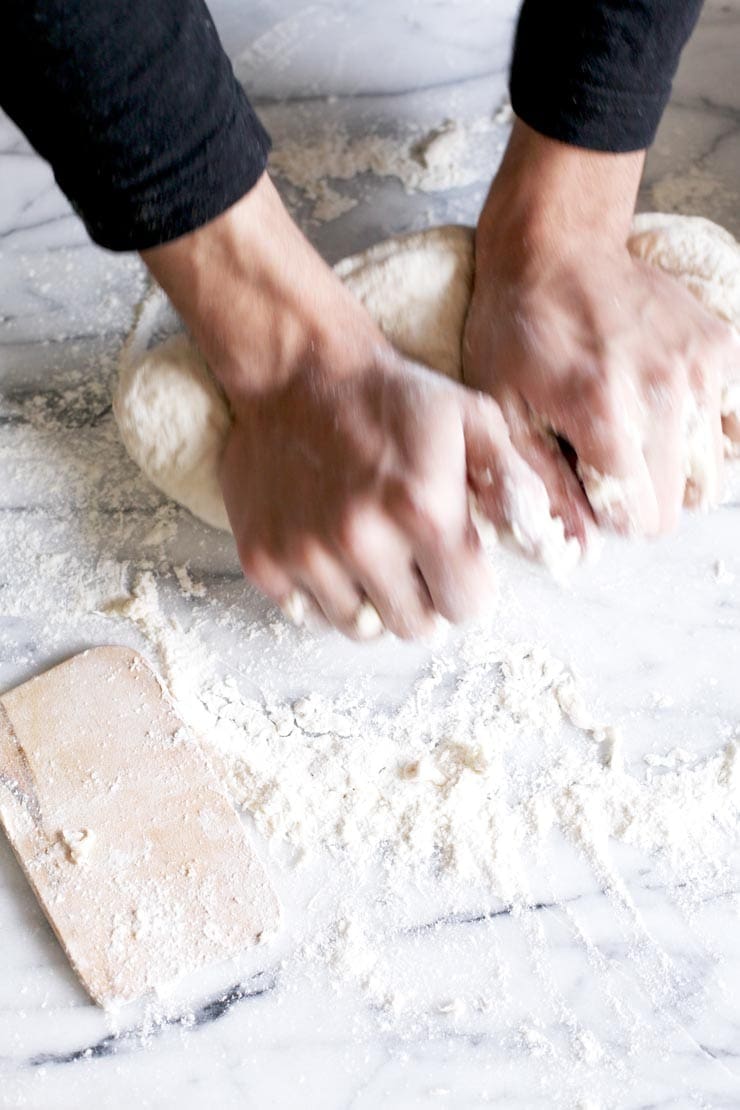
Then, mix the bagel dough together. You can you can opt to make the bagel dough by hand (which I highly recommend if you’re making this recipe for the firs time), or you can do so with a stand mixer fitted with the hook attachment, on the lowest setting (for about 5 to 6 minutes). If you’re making a double batch you might not be able to use your stand mixer for kneading– refer to your manufacturer’s instructions.
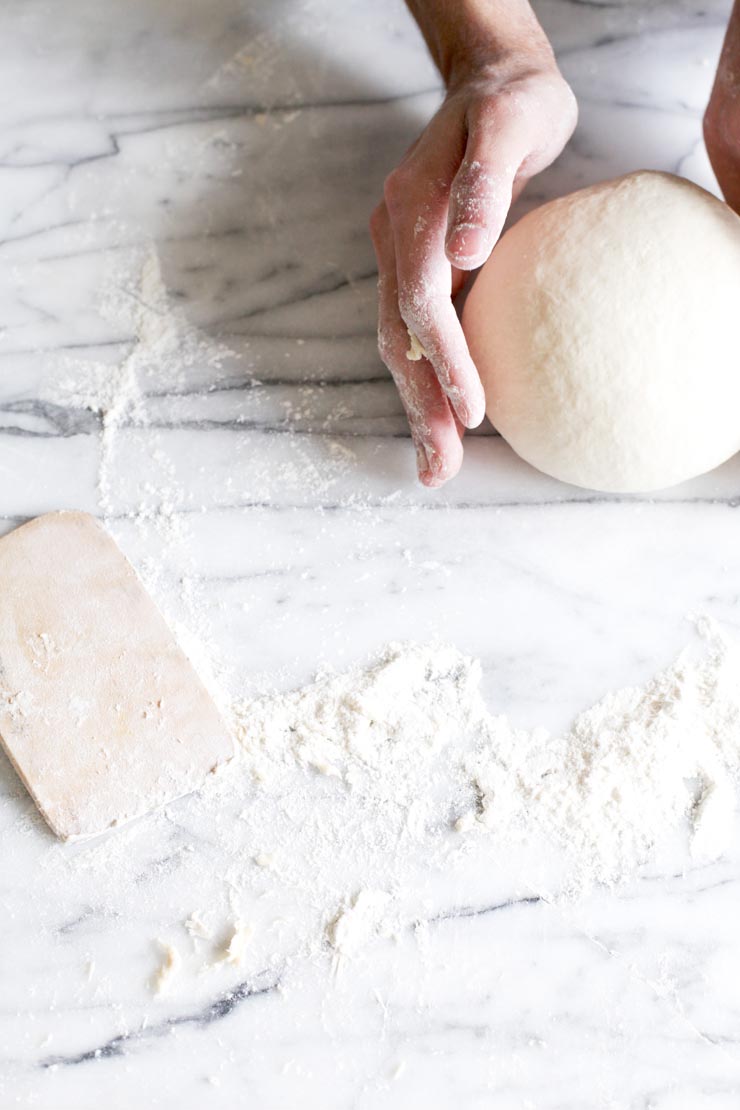
When mixing the bagel dough, you may or may not need the entirety of the water called for in the recipe. You want the bagel dough to be moist and firm after it is mixed. Sometimes you may need more water, depending on humidity, brand of flour, your altitude, climate, amongst many other things.
Once the dough has come together and has been kneaded, place the bagel dough in an oiled bowl to rest for an hour (about 2 hours if you’re using less yeast) or covered overnight in the refrigerator.
Once the bagel dough has rested, you will need to deflate it. You will know it has rested enough when you poke the dough with your finger and the impression remains. If it bounces back, the bagel dough has not risen enough.
If you allowed the bagel dough to rest in the refrigerator, allow it to sit at room temperature for about 1/2 hour before working with it.
Once deflated, divide the dough. It should be divided into 8 equal portions. Feel free to use a scale or eyeball it. You do not have to be exacting about this; just make sure they’re roughly even so that all the bagels bake at the same time.
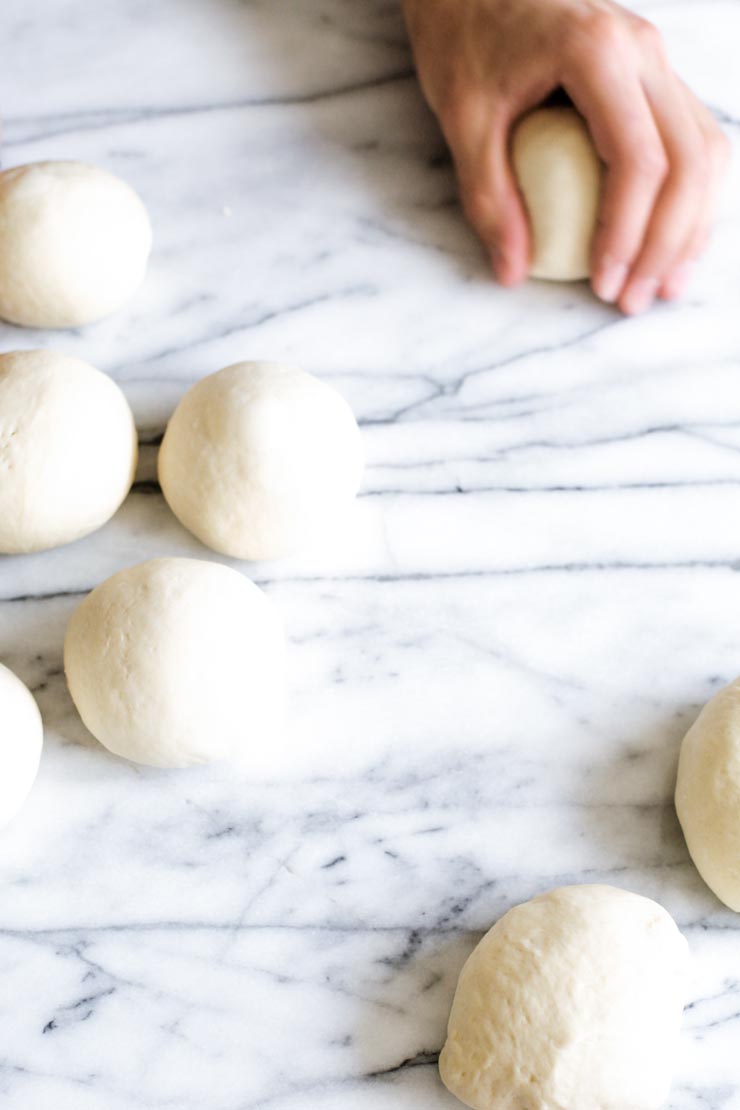
After that, form the bagel dough portions into rounds. Don’t use flour for this step. This is going to sound more complicated than it is, but hold your hand in a C shape while cupping a portion of dough.
Press the dough against the work surface (remember to avoid flouring it) and move your hand and the dough in a slow, circular motion. Allow the irregular edge of the dough to pull onto itself, while decreasing the pressure on top of the dough slightly until a perfectly smooth round ball forms.
Repeat this with the other portions. Have your eyes crossed? This probably does sound difficult at first, but essentially all you’re doing is making the dough round taut by pulling its sides in and keeping it round.
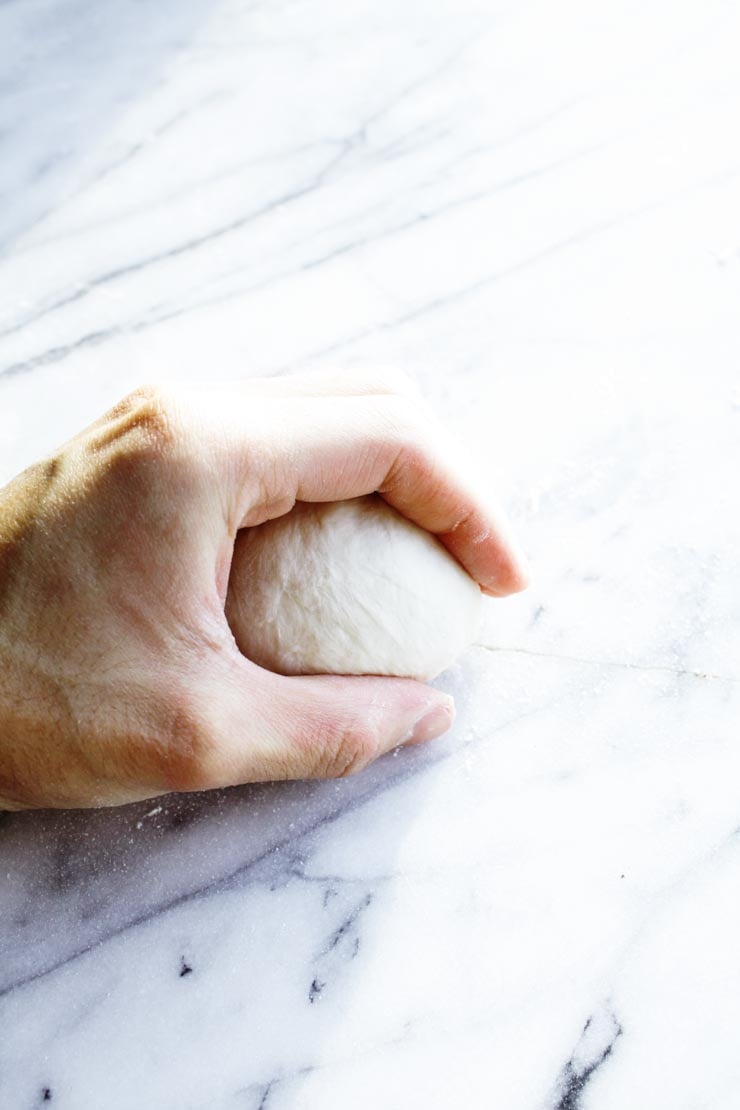
Now, here comes the part when we shape the bagel dough! Working gently and firmly with the dough will result in perfectly smooth bagels.
Simply coat a finger with flour and gently press your finger into the center of each dough ball. Then you stretch the rings out to about a third of the diameter of the bagel and place them onto a prepared baking sheet.
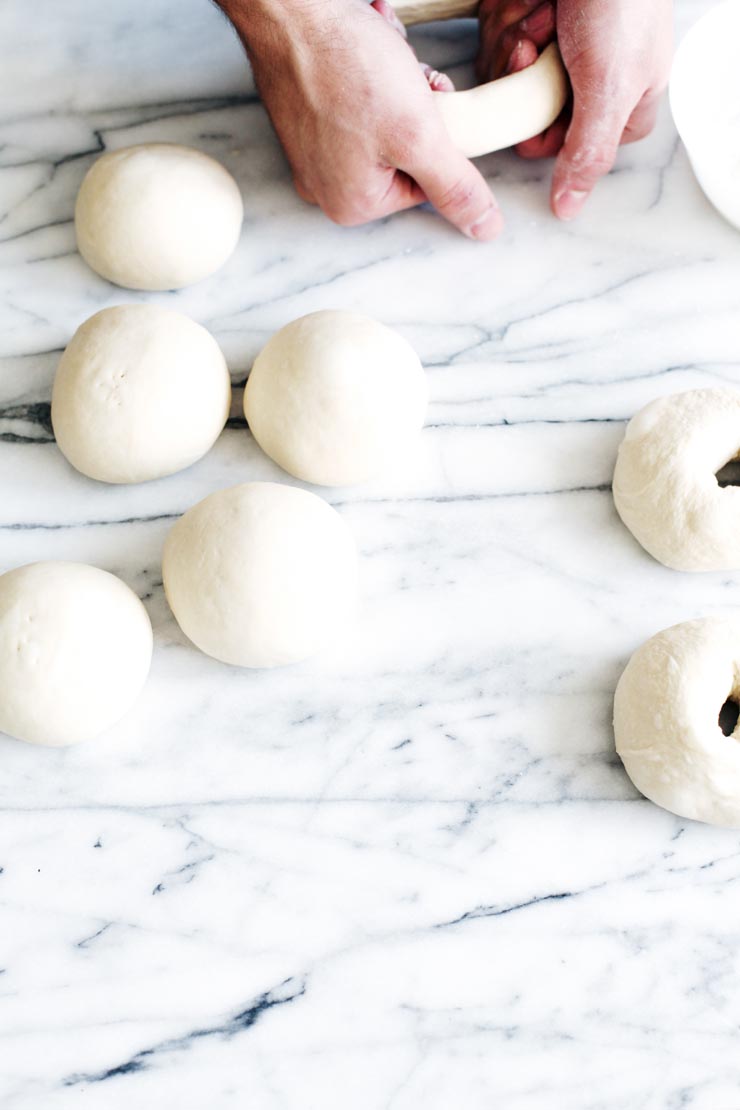
It’s time to boil the bagels. The bagels need a little rest in between shaping and boiling. So, while the unbaked bagels rest, bring a large pot of water to a bubbling boil.
Once it has reached a boil, lower the heat to a simmer. You’ll need a slotted spoon or a skimmer to place the bagels into the water. Some folks like to use small squares of parchment that they cut up before hand. Do what is most comfortable for you.
Handling the uncooked dough with the utmost care will preserve their shape as well.
Boil the bagels and don’t overcrowd the water. Boil as many bagels as you can comfortably fit into the pot. They will puff up quite a bit, so do keep in mind they do need some breathing room.
Once in the water, the bagels will float on the top. Let them sit for 1 minute, then gently flip them over to boil for another minute on the other side.
This will give them a nice crust and their signature New York-Style chew. You can go a little bit longer on the poach, as well. This will give them a stronger crust and chew– more on that in the recipe.
After boiling them, top the bagels! This is the time when you can let your creativity run free. You can use any or all of the topping options listed in the recipe.
Often times I do a combination of toppings to make a delicious homemade everything bagel. Sometimes I just keep it plain or stick to one ingredient on each bagel. Be creative!
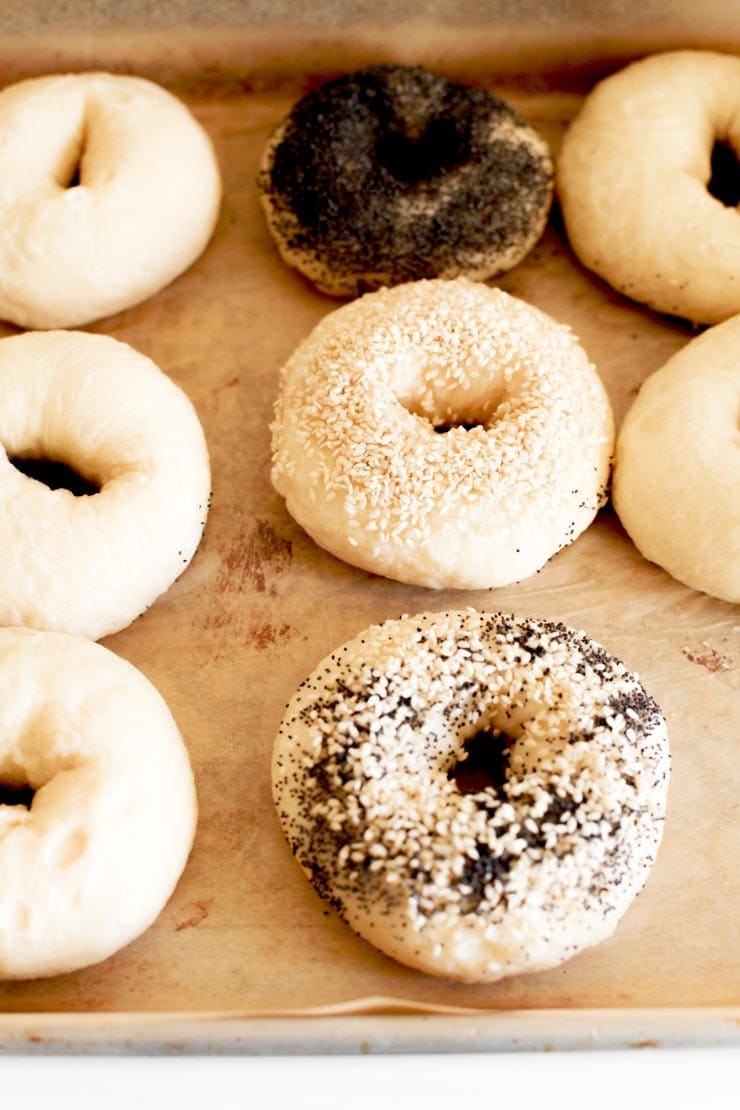
Once the bagels have been topped, bake them. Depending if your oven is calibrated or not (I like to keep an oven thermometer in mine to ensure it’s always accurate), you will need to bake the bagels between 20-25 minutes. Until they’re uniformly golden brown.
Now, here is the difficult part (not really). You’re supposed to let these cool for at least a few minutes once they’re out of the oven, until you can handle them. If you’re impatient like me, I brave through it, slice one open and schmear some cream cheese on mine right away.
Take a bite… Oooh, child!
Homemade New York-Style Bagel Serving Suggestions
There is no right or wrong way to eat a bagel. However, I’ve listed a few ideas and classic options you would enjoy. A schmear is a classic.
A bagel with lox is also another classic. If you’re looking for a good breakfast idea, go the New York City deli route and make yourself an Egg and Cheese Bagel. Bacon is preferred, but optional.
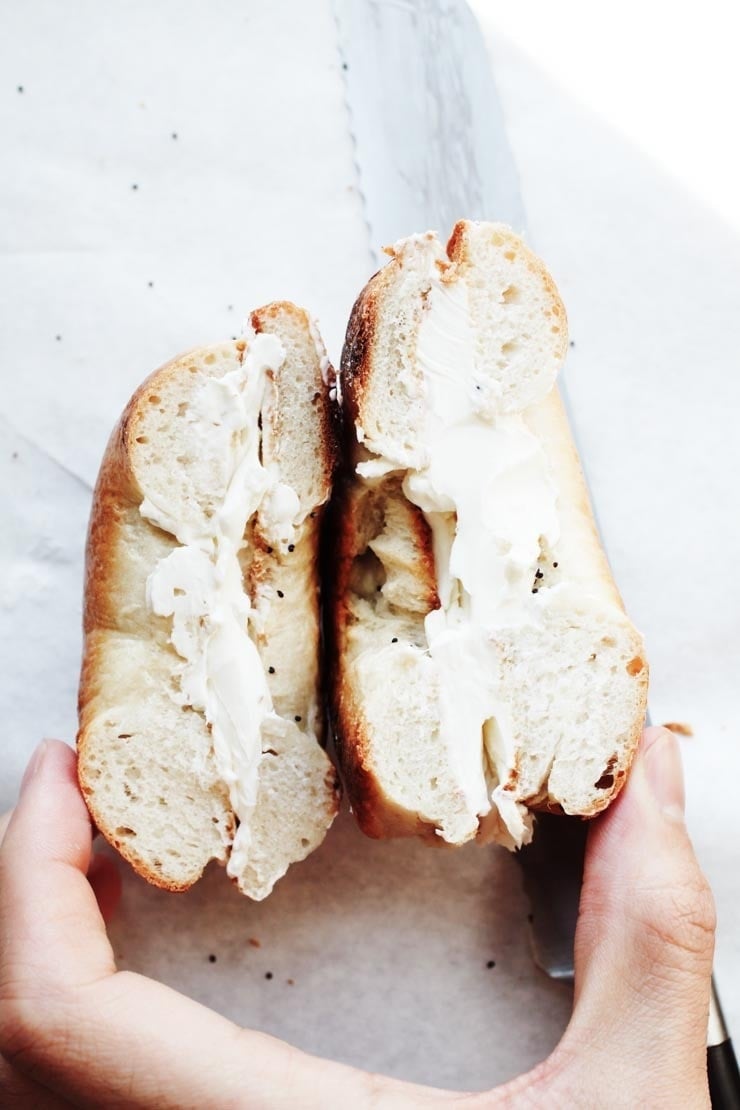
• Bagel with cream cheese– either plain, or your choice of flavored cream cheese. A schmear is a New York classic, and it’s so good.
• Bagel with butter– especially with homemade butter or a delicious French butter. Heavenly.
• Bagel with butter and jam– more specifically homemade butter and homemade strawberry jam– a match made in heaven. Highly recommended!
• Bagel with lox– add a schmear of cream cheese, lox on top, a slice of fresh tomato, red onion, thinly sliced cucumbers, and some deliciously briney capers. Perfection.
• Bagel with Avocado– a nice, healthy option. Toast the bagel, smash a ripe avocado on top, season to your liking, and serve it. Bacon is perfect on top, if you’re into that. Leftover guacamole is also delicious.
• Bagel with Egg and Cheese– this is New York City deli / bodega-style, peeps. Toast the bagel. Butter it lightly. Make an egg and cheese omelet to your liking. Or fry an egg up, over easy, season it with salt and pepper, top it with cheese and bacon. Add ketchup, if you’re into it. If not, add aioli, hot sauce, sriracha, sambal olek, or a combination thereof if you’d prefer that. Cut it in half. You’ll thank me later.
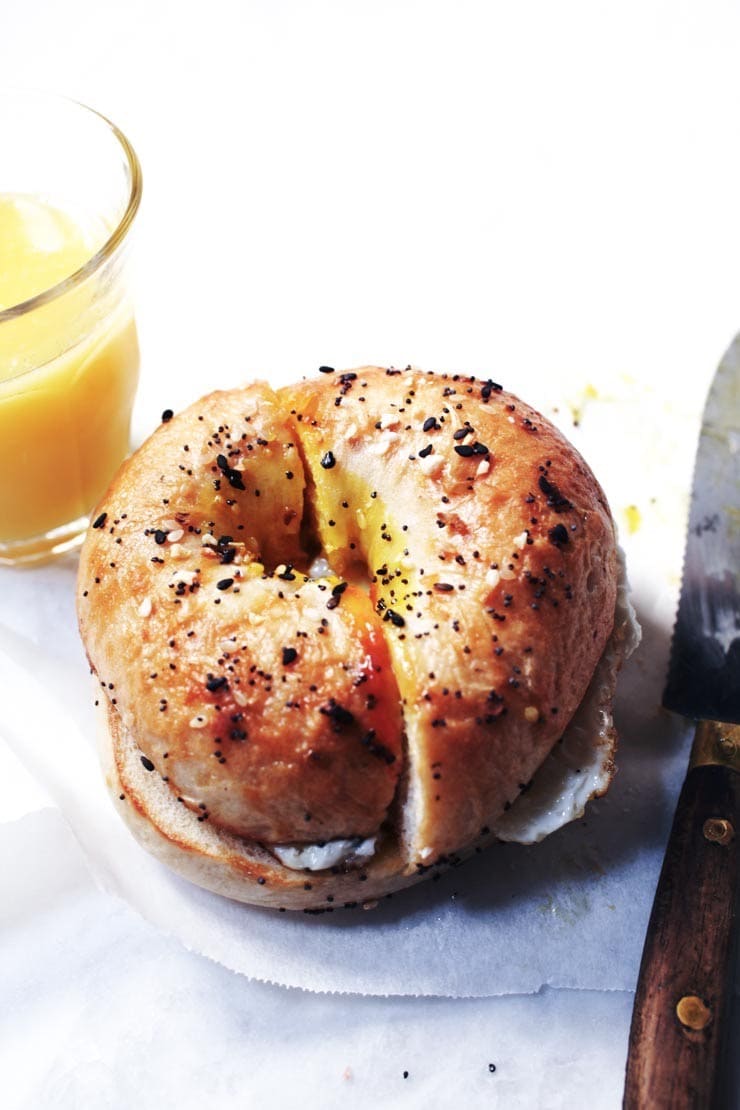
More Everyday Baking Recipes
- New York-Style Soft Pretzels
- Cinnamon Sugar Soft Pretzels
- Perfect Chocolate Cupcakes
- The Best Raspberry and Cream Scones
- Incredible Profiteroles
- Strawberry Pavlova
New York-Style Bagel Recipe

As a native New Yorker, I know there's nothing better than a fresh bagel schmeared with cream cheese. I no longer live in New York City, and I constantly crave the good old-fashioned bagels I grew up on– flavorful, modestly sweet, chewy ones with soft, shiny crusts.
These bagels are made the classic way: You boil them in water for a couple of minutes before you bake them. This is probably one of the most bizarre things a person can do to the dough, but it works. So, if good bagels cannot be found where you live, worry no more; this recipe is infinitely adaptable, and the little bit of effort you put into making these bagels is well worth it.
Ingredients
- 2 teaspoons / 6 g active dry yeast
- 4 ½ teaspoons / 19 g granulated sugar
- 1 ¼ cups / 300 ml warm water (you may need ± ¼ cup /60 ml more)
- 3 ½ cups / 440 g bread flour or high gluten flour (you may need up to 1/2 cup / 60g for kneading)
- 1 ½ teaspoons / 6 g salt
- Optional Toppings: (Refer to Notes)
Instructions
- In ½ cup /120ml of the warm water, pour in the sugar and yeast. Do not stir. Let it sit for five minutes, and then stir the yeast and sugar mixture until it all dissolves in the water.
- Mix the flour and salt in a large bowl. Make a well in the middle and pour in the yeast and sugar mixture.
- Pour 1/3 cup / 80ml of warm water into the well. Mix and stir in the rest of the water (the scant 1/2 cup / 100ml that is remaining), as needed. Depending on where you live, you may need to add an additional couple tablespoons to about ¼ cup/60ml of water. You want a moist and firm dough after you have mixed it.
- On a floured countertop, knead the dough for about 10 minutes until it is smooth and elastic. Try working in as much flour as possible to form a firm and stiff dough.
- Lightly brush a large bowl with oil and turn the dough to coat. Cover the bowl with a damp dish towel. Let rise in a warm place for 1 hour, until the dough has doubled in size. Punch the dough down, and let it rest for another 10 minutes.
- Carefully divide the dough into 8 pieces (I used a scale to be extra precise, but it’s not necessary). Shape each piece into a round. Now, take a dough ball, and press it gently against the countertop (or whatever work surface you’re using) moving your hand and the ball in a circular motion pulling the dough into itself while reducing the pressure on top of the dough slightly until a perfect dough ball forms (as pictured). Repeat with 7 other dough rounds.
- Coat a finger in flour, and gently press your finger into the center of each dough ball to form a ring. Stretch the ring to about ⅓ the diameter of the bagel and place on a lightly oiled cookie sheet. Repeat the same step with the remaining dough.
- After shaping the bagels and placing them on the cookie sheet, cover with a damp kitchen towel and allow to rest for 10 minutes. Meanwhile, preheat your oven to 425ºF / 220ºC / Gas Mark 7.
- Bring a large pot of water to a boil. Reduce the heat. Use a slotted spoon or skimmer to lower the bagels into the water. Boil as many as you are comfortable with boiling. Once the bagels are in, it shouldn’t take too long for them to float to the top (a couple seconds). Let them sit there for 1 minute, and then flip them over to boil for another minute. Extend the boiling times to 2 minutes each, if you’d prefer a chewier bagel (results will give you a more New York-Style bagel with this option).
- If you want to add toppings to your bagels, do so as you take them out of the water. Alternatively, you can use an egg wash to get the toppings to stick before baking the bagels. You may want to use the “Optional Toppings” listed above to top the bagels. Use just one topping, or a combination to make your own Everything Bagel Seasoning.
- Once all the bagels have boiled (and have been topped with your choice of toppings), transfer them to an oiled or parchment-lined baking sheet.
- Bake for 20 - 25 minutes, or until golden brown (I usually err on the side of 20 minutes).
- Cool on a wire rack (Or, if you’re impatient like I am, slice one of these babies open and spread on some of your favorite cream cheese or softened butter. Take a bite… Oh babyyy!)
Notes
Optional Toppings:
Caraway seeds, cinnamon sugar, coarse salt, minced fresh garlic, minced fresh onion, poppy seeds, sesame seeds, everything bagel seasoning, or a mix of your favorite flavors.
Water measurement & similar concerns:
The recipe measurements for the water in the recipe is a guide; not all 1 1/4 cups (300 ml) will be used unless you need it. This is because of environmental factors (humidity, temperature, altitude, etc.) and the flour you are using. The most important thing when making the dough is to make sure it is homogenous and smooth– do not get caught up on the water measurement. If the dough is too firm, add in more water to ensure the dough is not dry and flaky– this has to be done when mixing the dough, not after you’ve allowed it to rise.
For all other concerns, please review past comments and refer to the FAQ below the recipe card for this recipe.
Nutrition Information:
Yield:
8 Medium-Sized BagelsServing Size:
1 BagelAmount Per Serving: Calories: 228.4Trans Fat: 1.4gCholesterol: 0mgSodium: 441mgCarbohydrates: 44.4gFiber: 1.7gSugar: 2.4gProtein: 6g
New York-Style Bagel Recipe: Frequently Asked Questions (FAQs)
The following is a comprehensive list of Frequently Asked Questions I receive about this New York-Style Bagel Recipe. You will find answers to your questions about Yeast, types of flour you can use, and everything you may need to keep in mind when it comes to preparing this homemade bagel recipe and storing the bagels properly.
The Yeast
Can I use fresh yeast?
If you are unable to get active dry or instant yeast, you can use fresh yeast. The general rule of thumb is a ratio of 2.5:1, fresh to active dry. The amount of active dry yeast used in the recipe is only 6 grams, you would need about 15 grams of fresh yeast.
When substituting fresh yeast, you may want to make a few adjustments to the method. Fresh yeast does not need to be proofed like active dry yeast. The water, sugar, and yeast step will be unnecessary in this case, so do keep that in mind. But, as some have told me, they’ve simply substituted fresh yeast for the active dry yeast and followed the steps as directed without any issues.
Can I use instant yeast for this bagels recipe?
You can. Substitute an equal amount. There’s no need to proof the yeast, so add the yeast to the flour with the sugar and jump straight to making the dough.
I prefer less of a yeasty bread-like flavor, how can I achieve that?
You can reduce the amount of active dry yeast to 1 teaspoon in the recipe. Do note: you will have to double the rising time to about 2 hours, instead.
Types of Flour
What if I can’t find bread flour? Can I substitute regular (all-purpose) flour?
If you don’t have access to bread flour, it is okay to use all-purpose flour; they will still come out wonderfully. Alternatively, if you can find vital wheat gluten (it’s usually carried at health food stores), add 4 teaspoons to the all-purpose flour, and you should have a good substitute for the bread flour called for in the recipe.
• Can I make bagels with whole-wheat flour?
Yes, simply use half whole-wheat flour and half bread flour. If you like a milder tasting bagel, you can use white whole-wheat flour.
• Can I use spelt flour for bagels?
Yes. Use 2 cups / 255 g whole-wheat flour and 2 1/2 cups / 315 g sifted spelt four. Alternatively, readers have told me that they’ve made the bagels entirely out of spelt flour with great success.
Preparation
How hot should the water be to proof the yeast?
The water should ideally be between 105F / 40.5C – 115F / 46C.
Can I prepare the bagel dough in my bread maker or KitchenAid / stand mixer?
You can absolutely use either. For a stand mixer: use the hook attachment, and knead the dough on the lowest setting. Do this for 5 to 6 minutes until smooth and springy. If you’re making a double batch, you might not be able to use your stand mixer for kneading. Please refer to the manufacturer’s instructions.
My bagels aren’t smooth. What did I do wrong?
There’s two factors that come into play here: the way the dough is handled and the water the dough is boiled in. Being gentle is crucial to the formation of smooth looking bagels. The less you handle it, the smoother it will be. If you squeeze the dough roughly, it’ll turn out wrinkly. Like many folks, I bake these bagels a lot, and some batches come out smooth and gorgeous, and on bad days some come out wrinkly. It’s all about how you handle the dough, but in the end- it always tastes amazing!
When it comes to boiling, make sure the water is not at a rolling boil. This will also prevent them from looking rough.
How can I achieve an even shinier, sweeter bagel? Can I use barley malt or honey?
Yes! This will achieve a slightly sweeter and shinier product. Use about 1 teaspoon of barley malt in the dough and a generous tablespoon in the pot of boiling water. Because barley malt is not easy to find, I have not made it a required ingredient for the recipe. However, it does add a delicious taste. Alternatively, you can use a couple tablespoons of brown sugar and/ or honey in the boiling water to achieve a similar effect.
Do the bagels need an eggwash before they go into the oven?
No, an egg wash is not necessary, though it does give a beautiful sheen to the bagels. The bagels will be just as beautiful and delicious if you forego the egg wash. This is especially a great option for vegans.
Once boiled, add toppings to the wet, unbaked bagels immediately so that the toppings stick.
My bagels stuck to my pan. What can I do to prevent this in the future?
The original recipe calls for simply using an oiled pan (I’ve edited it). Like many folks, I am paranoid about things sticking to pans, so I use parchment paper or a silpat baking mat (as shown in this post). Feel free to do the same. I do oil the parchment just a bit to add a little bit of extra non-stick protection, but it’s not necessary.
I live at high elevation, what can I do to ensure these come out properly?
I’ve been told by bakers who live at a higher elevation that this recipe works well as is. However, I know that high-altitude baking, especially with yeast, can be a headache as dough tends to rise about 25 to 50 percent quicker than at lower altitudes, so do keep that in mind.
A sure-fire way to ensure that the finished product is not very dense would be to reduce the amount of yeast to 1 teaspoon and allow the dough to rise for the recommended time in the recipe. If the dough has doubled in size after 1-hour, it’s good to start working with. If not, continue to let it rise, checking on it every 15 minutes until doubled in size. Your altitude, brand of flour, humidity, and room temperature are factors that would make the rising times vary.
Can I make the bagels bigger?
You can, just keep in mind that they will need longer to bake. Check on them every few minutes past the 20 minute mark until they are uniformly golden brown.
Make Ahead and Storage
How can I make the dough ahead of time? Can I refrigerate the dough over night?
The best means of making the dough ahead of time would be to prepare it, cover its container with plastic wrap, and rest it over night in the refrigerator. This is called a cold-rise. I often do this and I love this method because it allows the dough to achieve a more complex flavor. If you are doing a cold rise, be sure to allow the dough about 1/2 hour to come to room temperature before working with it.
Can I par-bake the bagels for later baking?
Yes, you can bake them until they are a faint gold tinge (about 10-15 minutes). Cool the par-baked bagels completely before storing them in a resealable bag to be stored in the freezer. To be bake from frozen, bake the bagels for an additional 10-15 minutes, until soft and golden brown.
Can I freeze the bagels? Do they keep well?
Once cool, out of the oven, you can freeze the bagels without any issues. Slice them and then freeze them in a freezer-safe plastic bag, and let them thaw when needed. If you’re planning on toasting them, thawing them is unnecessary.
How long do the bagels stay fresh for?
The bagels will keep in a resealable plastic bag at room temperature for up to 2 days.
Updated May 14th, 2020 – As one of the most popular recipes here and in my book, I’ve received many questions about this bagel recipe. For your convenience, I’ve updated the post with photos, more information, and answers to your Frequently Asked Questions.
Have another question? Leave a comment below!

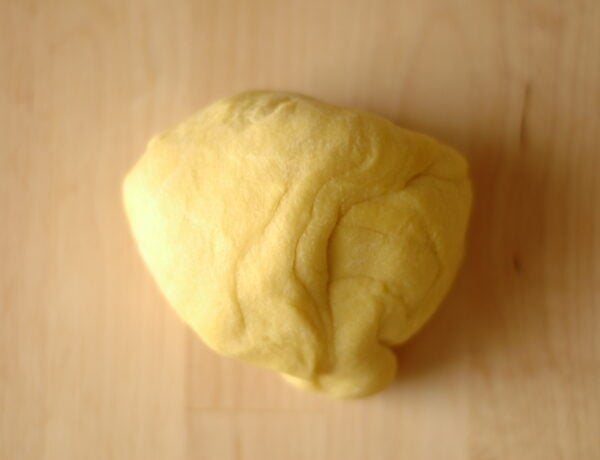
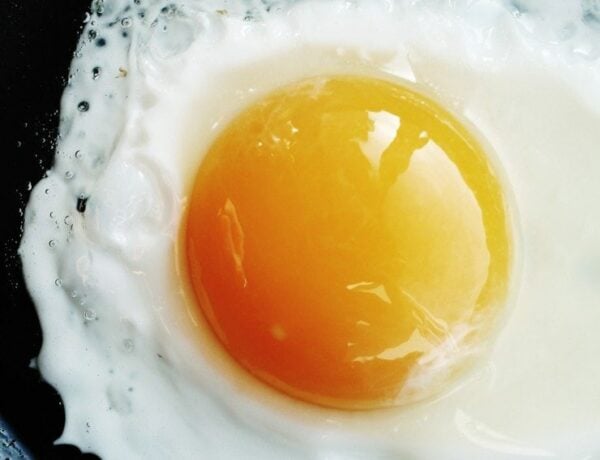
1,530 Comments
Jenna
April 26, 2020 at 7:44 pmI was so excited to find this recipe with a fantastic eating and so many comments to back it up! :) thanks for sharing, Kamran! As I made my first batch today, I ran into a few issues and was beyond grateful to see you’re still replying to comments and questions, 11 years after this was posted! (I apologize in advance for the lengthy post!) I completed my first batch entirely in my KitchenAid fitted with hook attachment. After adding the yeast mixture and the additional 1/3 cup water, my dough was not coming together and was quite flaky. I added the additional water 1 Tbsp. at a time but ended up using all of it and still having to manipulate the dough together with my hands before continuing to knead with the hook. Then I had difficulty getting it to rise. After a few different relocations throughout the house, my hunger got to me and proceeded…assuming this lead to my next Issue of the bagels not floating at all in the water. I still baked them and they’re almost there…just not quite! My second round, I started in the mixer, ended up using all of the water (plus a splash more!) and still had flaky issues. I removed and forced together by hand/ kneaded by hand but the dough was super tough. Am I over-developing the gluten? I cranked the heat up in our guest room, hoping to get a good rise… any thoughts on what I could be doing wrong?! Any advice is so much appreciated!
Kamran Siddiqi
April 26, 2020 at 8:52 pmHi Jenna- depending on your environment (humidity, room temperature, etc), brand of flour, and even the brand of yeast you use, you may need to add more water than what is called for in the recipe. The goal here is to make a smooth and firm dough– not one that is flaky. So, if you need to add more water, please don’t be afraid to do so. This needs to be almost like firm Play-Doh.
Sometimes you do have to get your hands in there when working with a stand mixer; that’s inevitable. When using your KitchenAid, use the lowest setting possible and make sure you don’t knead the dough for more than 5-6 minutes. After that point, it’s likely you’ve over-kneaded the dough. You want a smooth dough that pulls away from the sides of the bowl and onto the dough hook. You may need to get in there and use your hands to manipulate the dough a bit (with the mixer off, of course).
As for the rise- you need to make sure your water is not too warm as it can kill the yeast (which you also want to make sure is fresh– if the yeast bubbled up when you let it sit, it should be fine). You want it to be between 105ºF/ 40.5ºC and 110ºF/ 43ºC (anything too cold won’t activate the yeast, anything too hot will kill the yeast).
The dough will take either take an hour to rise, or maybe longer– this is dependent on the environment it is set to rise in (you can rise it in your microwave after you’ve heated up some water in there, or in the oven while it is switched off).
If the yeast is still alive, the dough should rise even if you were to do a cold rise in the refrigerator overnight (please refer to the FAQ page linked in this post to read more about that). I think the problem you’re experiencing is that your dough isn’t moist enough and not coming together. It may have been worked too much as well (yes to possibly over-developing the gluten). If your dough gets too sticky when you add water to it, just a touch more of flour. Bread baking is about feel, so just turn the machine off a couple times and give it a feel to see how it’s doing. I hope that answers your questions! If not, send me an email and I’ll be happy to help. :)
Allie
April 27, 2020 at 12:09 amJoining the COVID-19 bagel-making crew. Just made these. I was a little unclear on the water… and guess I must just be the only one. So you use the 1/2 cup water with the yeast, then add the 1/3 cup water with the flour mixture. I added a 1/4 cup cause my dough was way too dry, but then where’s the other approx. .2 cups of water that is originally asked for in the ingredients list? Am I just missing a glaring detail here? Thanks so much, even with less water, my final products look phenomenal!! Just ugly bottoms, haha.
Meg
April 27, 2020 at 7:20 pmI’ve never commented on a recipe before but OMG I just made these (after never even trying making bagels before and being a total novice in the kitchen) and they were amazing! And so easy. I used 1 cup bread flour (all I had – coronavirus times!) and the rest AP. For those asking, they have an FAQ where they say it’s fine to use AP. Used an everything bagel seasoning on half and sea salt on the other. Accidentally set my oven to 550 (lol) and took them out around 17 minutes in and they were fine! YOLO! Love them and will definitely make them again!
Alisa
April 29, 2020 at 4:12 amFantastic recipe with rave reviews from my picky eaters! I used molasses instead of barely syrup and it added a nice sweetness.
Hugh
May 1, 2020 at 2:08 pmI am confused how much water to add. At the top you say 300 ml (with maybe +60ml extra) but in the reciepe you only mention 120 + 90 (+60 potentially extra) – that doesn’t add up the total amount…..
Kamran Siddiqi
May 2, 2020 at 10:20 amHugh- Just follow what the directions state. The water called for in the ingredients list might be a little more than you may need, which is why it doesn’t add up.
Deb Tait
May 2, 2020 at 8:52 amWow, they turned out amazing! I did a cheese topping, the best bagels I’ve ever had!
Divya Saraf
May 2, 2020 at 12:21 pmHi
Can I substitute fresh wet yeast for dry yeast ? If yes how
Kamran Siddiqi
May 4, 2020 at 6:56 pmHi Divya, please refer to the FAQ page linked to in the post.
KM
May 3, 2020 at 10:28 amI bake quite a bit and tried these but ended up having to throw away the dough. When I first tried to mix it, it became super crumbly. I tried adding more warm water, but nothing helped and the dough wasn’t sticky after kneading/kept having cracks throughout it. Any idea what could have gone wrong? I’ve never seen this before when making bread and followed the recipe exactly.
Kamran Siddiqi
May 4, 2020 at 7:02 pmKM- if the dough is dry and crumbly, it simply needs more water until it becomes firm and moist.
Emily Johns
May 3, 2020 at 7:41 pmMade your recipe and the texture and taste are great! I might need to bake them a few minutes more next time, but I put a cinnamon sugar coconut topping on some and was scared of the topping burning (maybe cover with tinfoil towards the end next time).
Two questions:
When I was boiling the bagels none of them sank and then floated they all only floated. What did I do wrong?
I did an overnight rise in the fridge.
Other recipes I read talked about a yukone and dough. Wondering if you have tried and have thoughts?
Kamran Siddiqi
May 4, 2020 at 6:55 pmHi Emily, Ideally, you want them to only float as this means your dough was well made, rested nicely, and you’ll end up with nice bagels. If they just sink that’s when you should be worried. I have not tried a yukone dough for this recipe; it’s over a decade old and I haven’t tried to fix what isn’t broken, other than updating the recipe a bit in my book.
Niki
May 4, 2020 at 1:20 amHi! I made the first batch of these bagels a couple of weeks ago and they turned out so well! However tried again today- the dough was looking great until it came out of the boiling water, they rapidly lost their “puff” and became very dense, ugly looking things. I tried baking them anyway but just very chewy, doughy and way too dense. Any tips on what I might have done wrong? Thank you!
Kamran Siddiqi
May 4, 2020 at 6:52 pmHi Niki, they may have rested for too long between forming and boiling them.
Elizabeth
May 4, 2020 at 11:54 amLiterally the best bagels I’ve ever had! It is very hard for me to follow a recipe. I followed this recipe exactly and the bagels are actual perfection. The 10 minute knead is the most important part in my opinion. Sometimes I give up a few minutes in, once the dough has come together. But after 10 minutes of effort, I really did notice such a change in the pliability and consistency of the dough. They also expanded significantly in the bath and oven, which was a pleasant surprise.
Emily
May 4, 2020 at 11:14 pmMakes sense thanks! I’m late to this recipe:) I’m interested in a jalapeño cheddar and Asiago cheese version. Can I make this dough and add additional dry ingredients? Or would I have to alter the dough at all?
Kamran Siddiqi
May 4, 2020 at 11:29 pmHi Emily, You sure can! The dough is pretty forgiving when it comes to mix-ins, so a couple tablespoons of jalapeño kneaded into the dough and some cheese inside and on top of the dough should work. I know a few commenters have made asiago and jalapeño bagels with the recipe, so it shouldn’t be any issue. Hope that helps!
John Coxe
May 5, 2020 at 11:01 pmIf you want some of your batch to be Pretzel Bagels, make them at the end by adding baking soda to the boiling water and top with kosher salt.
Danielle
May 6, 2020 at 9:27 amI know you have so many reviews already, but I just wanted to thank you for this recipe! I am a relative novice at bread making, but watch a lot of cooking shows and after reading your recipe it seemed like something I could make. Due to covid-19, all of my favorite bagel shops in town are closed. I’m currently pregnant and have been craving a good salt bagel!
I made with AP flour so ended up kneading a bit longer in the KitchenAid (did a window pane test). I also did a cold rise in the fridge overnight. My house was pretty cool this morning so I had to add another 10 minutes to the time to bring it up to room temp after getting out of the fridge, but they were very easy to make and taste like the real deal!
Five stars, two thumbs up
Anu
May 6, 2020 at 4:00 pmThanks for the wonderful recipe.
Donda
May 8, 2020 at 4:19 amI love this style. Thank you for such a great recipe.
Josh Andrews
May 8, 2020 at 12:36 pmI made your bagels yesterday (amazing btw) and shared the pics to fb… in the 18 hours since, I’ve had 11 people ask for the recipe. Thanks for the amazing bagels!
Kelly Bartolo
May 9, 2020 at 8:58 amJust made these and they turned out great! followed instructions to the T and couldn’t have asked for better results!
Kate
May 9, 2020 at 12:21 pmThank you for this wonderful recipe and all the detailed instructions and tips. I haven’t had a good bagel since i moved to Georgia. For maybe the first time in my life I followed your recipe exactly and I got a wonderful result. I did let my kitchen aid do the kneading for me though. Now I have to learn more about Barley Malt Syrup-does it take the place of the sugar? I think I’m going to try it. I have another batch proofing right now!
Kamran Siddiqi
May 9, 2020 at 5:10 pmHi Kate, please refer to the FAQ page linked in the post. I talk about that under the bit about “Preparation,” you’d add some to the dough and some to the pot of boiling water.
Oliver
May 9, 2020 at 4:43 pmHi Kamran
– For the cold rise in the fridge, is there a maximum time you would leave it in there? 12-16 hours?
Kamran Siddiqi
May 9, 2020 at 5:14 pmHi Oliver, I wouldn’t do more than 16-hours for a cold rise for this recipe. After that, I fear it might alter the taste of the final product. With that being said, definitely go for 1 teaspoon of yeast instead if you are doing such an extended cold rise. It’ll save you yeast!
Mel
May 11, 2020 at 10:45 amJust wow! Best bagels ever! i tried another recipe just to compare and my husband said they were rubbish and to stick to your recipe! :-) I do have one question… if i want to add dried garlic and onion to the dough (rather than as a topping) could i do this (and at which stage) or woud it impact the dough?
Markela
May 11, 2020 at 12:53 pmI’ve made these bagels three times already and they’re amazing! My husband, a true New Yorker, approves! Just a quick hint, achieving the perfect shape is a bit hard. It took me three tries and still haven’t perfected it.
Melissa
May 11, 2020 at 11:42 pmI made these a few days ago. The dough was extremely dense and dry – I had to add a few more tablespoons of water just to make it kneadable. The dough didn’t really shape; I had lumpy looking dough bits that I poked my finger through. They ended up tasting pretty good on the first day, but by day 2 they were dense and hard to chew. What did I do wrong?? (BTW – a friend of mine tried also and got the exact same results as me.)
Kamran Siddiqi
May 12, 2020 at 12:00 amMelissa- thanks for the comment. Sounds like you needed to add more water. If you are improperly measuring your flour, that could be a big factor. However, simply not adding enough water to the mixture to form a smooth and firm dough will lead to dry and crackly bagels. The measurement for the water called for in the recipe is simply a guide. If you somehow end up using the entire 1 1/4 cups, you’ll need to add another 1/4 cup, as noted in the recipe. And sometimes you might need even more than that. If you don’t get this step down, the bagels will not be their very best.
If you have baked bread before, you’ll know that depending on humidity, type of flour, how the flour is measured, etc. can alter the way the dough comes together, how much water it can take, and how quickly (or slowly) it rises. If you’re using a stand mixer, I highly encourage you to at least bring the dough together with your hands, and let the stand mixer do the rest of your kneading. You’ll get a better feel for the dough. You’ll need to feel the dough and just do what makes sense for it. If it is too dry, add more water. If it is too sticky, add more flour. If the dough does not want to take in more flour while you’re kneading it, don’t feed it more flour. The end result for the dough that you need to keep in mind is: it needs to be firm and smooth. The recipe video shows how the dough should appear, and so does the photo within the recipe card, so definitely reference those if you would like to have another go.
sofia kjellgren
May 12, 2020 at 7:19 amBest recipe ever! Thank YOU!
Ali
May 13, 2020 at 1:18 amThese are AMAZING! I made them yesterday and my kids couldn’t believe they were homemade!! They were so good I made another batch tonight! Thank you for this recipe. Some of my bagels came out rustic looking, but OMG who cares that just gives these golden delicious masterpieces more charm! Very happy and thankful!
Suzanne Hamilton
May 13, 2020 at 7:44 pmI made these last week and ate one as soon as cool enough to handle. My problem was the next day they were pretty hard to eat. By the second day they were rocks. I did zipper bag them when they were cool enough to do so.
I used my bread machine and my guess is the kneading and rising were off . Would that cause the problem?
Kamran Siddiqi
May 14, 2020 at 9:09 pmHi Suzanne- there are various factors that could have caused your bagels to go stale. I make these bagels often and a lot, and they are still soft the second day when I put them in resealable bags and leave them at room temperature. I make sure as much air is out of the bags as possible to ensure their freshness. Because this is a homemade bagel and it is made without anything to add richness to it and it does not have any preservatives, it will start to go stale and not be as fresh as day 1. This can’t be controlled; when you get fresh bread from the bakery, this happens too. The other thing is, as you said, you used your bread machine for kneading and rising- this could have been a contributing factor. You don’t want to over knead the dough. Another factor could be that you did not boil them long enough. Did you leave them in for 2 minutes? The brand of flour used or climate in which the bagels are being kept in can also cause them to go stale quicker.
Bri Rodriguez
May 15, 2020 at 7:03 amI want to start by saying that this recipe is one of the best bagel recipes that I have ever tried! This particular recipe drove my passion for baking and eating a lot more while stuck at home. No more trips to the bagel shop for me.
Kristen S
May 16, 2020 at 11:34 amHi! I love your bagel recipe and plan on trying the cinnamon raisin recipe soon. In your cookbook, you say to sift together 1tbsp dark brown sugar, 50g granulated sugar, and 1 tbsp ground cinnamon in the flour. Do I still use the 4 1/2 teaspoons of granulated sugar in this recipe in addition to the parts mentioned above? Thanks! This has been the most fail-proof recipe I’ve ever used, and as a native New Jerseyan living in the Midwest, this helps cope with the lack of bagels here.
Kamran Siddiqi
May 16, 2020 at 6:48 pmHi Kristen- thanks so much for the love! The mix-ins for the cinnamon raisin recipe are in addition to the 4 1/2 teaspoons of granulated sugar used to proof the yeast. I hope that helps!
Lucille Hyman
May 16, 2020 at 3:54 pmSuzanne Hamilton. I’ve been making these Bagels for years. The best thing I find is to Freeze them at least the same evening that you’ve made them. I also use my bread maker to mix & partially knead the ingredients. I alway knead then just a bit more after taking out dough from it. Make sure your bread maker has a Manual bread making selection. I hope this helps.
My question is – I now have Rapid rise yeast instead of my go to flesihmans regular yeast jar that I keep in the fridge. Does anyone know how different this type of yeast will make my bagels?
Lucille Hyman
May 16, 2020 at 4:06 pmI have another question actually it’s a bit of a problem I’ve occasionally run across. After boiling my bagels then while the rest are waiting for others so I can bake all together I’ve had a few Bagels deflate..? Any suggestions.. or Advice.. I want every single one to come out like the rest because they go very quickly. I’ve also had a few NY friends tell me I should sell them here in SC, Lol. Thank you in advance :-)
Kamran Siddiqi
May 16, 2020 at 6:46 pmHi Lucille, rapid rise / instant yeast will work in a pinch (just refer to the FAQ). The dough might rise a bit sooner, so just keep that in mind! In regards to the bagels deflating, I suspect it’s because they were over-proofed after being formed. Before you start to form them have the water starting to boil that way the bagels don’t rise too much while they are waiting to be boiled. I hope that helps, and thanks so much for contributing your love and time into this recipe as well :)
Angela W.
May 16, 2020 at 7:27 pmKam, thank you. I don’t normally comment, but I need to tonight. I am a New Yorker stuck in the middle of England and I miss home so much! THANK YOU so much for a recipe that is helping my family and I get through this time. God bless you and your loved ones!
This has been my go to recipe for YEARS. We are making these up to 3x a week. I am so happy to see that you are always updating this page to share more and more knowledge about bagels and how to ensure everyone has a successful outcome. I always follow the recipe to the T and they come out perfectly. Thank you, thank you, thank you!
Kamran Siddiqi
May 17, 2020 at 4:31 amAngela- Thank you for the love and positive vibes; it is my pleasure! Be well!
Phil
May 17, 2020 at 8:04 amThese bagels are a HUGE HIT with everyone that I’ve shared them with! It’s a fairly easy recipe, and your directions are incredibly clear & easy to understand….Thank you so much for sharing with all of us!
The one problem that I have, is that they don’t last long….they get eaten-up very quickly!
Can I simply double the recipe, or do I need to keep making the individual batches as you’ve described above?
Kamran Siddiqi
May 17, 2020 at 1:35 pmPhil- I have doubled the recipe many times with great success. Just keep in mind that if you’re using a standard stand mixer to mix your dough, you might have to work in batches as most stand mixers can’t handle that much bread dough. Hope that helps!
Marina
May 17, 2020 at 10:12 amI’m pretty sure I messed these up, I just found out I didn’t understand the measurements well, yet they came out lovely! I will definitely make these -correctly- again. It was my first time making bagels (not my first making bread) and I am very happy with the outcome. I had seen all these painfully long recipes and I was kind of reluctant about this one. Now I have a bag full of bagels in my freezer and I can have one anytime I want. I’m really glad I stumbled across this recipe and this page!
Mary Mucciacciaro
May 17, 2020 at 11:07 amHi.. I tried these for the first time… these bagels are amazing. My whole family loves them. I stumbled on a video for this recipe and now I cannot find it again. Is one available.
Thanks,
Mary M.
Kamran Siddiqi
May 17, 2020 at 1:36 pmHi Mary- it’s still in the post.
Stacy
May 17, 2020 at 11:59 amHi! Can I use brewers yeast for this recipe?
Kamran Siddiqi
May 17, 2020 at 1:51 pmHi Stacy- While you can, I wouldn’t suggest it because brewer’s yeast has a bitter flavor and is not exactly ideal for the flavor of bagels. However, if that’s all you have and you don’t mind experimenting, keep in mind you will need slightly cooler water to activate brewer’s yeast (90-100ºF). I would halve the amount of yeast called for in the recipe, do a cold rise overnight (as suggested in the FAQ) or double the rising time at room temperature. When halving the yeast, it sometimes ends up being about 1.5 hours for rising– just allow the dough to rest and rise until doubled in size, that’s the goal for the first rise. I hope that helps, and I’d love to hear if you do try it with the brewer’s yeast!
Allison Simcox
May 17, 2020 at 1:19 pmThis recipe is fantastic! We LOVE NY style bagels as my husband grew up there, but we live on the west coast, and these are the best we’ve had outside of NYC! One question : I’m only able to find rapid yeast, and I saw your suggestion to skip the proof and add it directly with the sugar. I’m that case, so I still add the 1/2 c warm water to the recipe or skip it? Thank you!!!
Kamran Siddiqi
May 17, 2020 at 1:40 pmHi Allison- You’ll definitely want to add the 1/2 cup of warm water, once the dry ingredients are mixed. Then continue as stated in the recipe.
Marilyn Stevens
May 17, 2020 at 4:30 pmWe’re pretty bagel deprived in Costa Rica, so when one friend posted your recipe on FB, we all started sharing it. I think at least a half dozen folks have made these ( maybe up to a baker’s dozen by now – haha)! They’re terrific. I hadn’t made them in a few weeks, so when one of my friends posted his first attempt, I got inspired … They’re wafting beautiful aromas from the oven through my house as I write this. Gracias!
Sarah Chan
May 18, 2020 at 1:41 amAbsolutely love this recipe, family devoured in one go! Haven’t been able to find bagels in Barcelona but now I don’t have to look anymore! Am just wondering if its possible to make that dough the night before and proof in the fridge overnight or is is better to do it all on the same day of baking? Thanks in advance :)
Milan Aspe
May 18, 2020 at 11:32 pmLOVE this recipe. I am experienced making bread but not bagels. Turned out amazing the first time. Personally I would boil for 2 mins/side next time to experiment. They were super fluffy and wonderful but I wanted more chew. I tossed in 1 tbsp of chopped fresh rosemary. Would double next time and sprinkle more on top for more flavor. Was amazing regardless.
Chrissy
May 19, 2020 at 12:03 amScreaming THANK YOU for this recipe. Absolutely delicious, authentic, and amazing directions. Thank you!!!
Sarah Gresham Barr
May 19, 2020 at 11:19 amI have never made bagels before, but I made these last night and HOLY MOLY they’re amazing. I had to use all-purpose flour because everyone and their mom had bought Kroger out of bread flour, but they still turned out beautifully. I made 4 plain bagels, 2 everything, and 2 asiago– a simple egg wash held all the toppings on perfectly. The instructions were so easy to follow! My bagels definitely weren’t very pretty, but they were so delicious. I can’t wait to make my next batch!
Allison
May 19, 2020 at 1:03 pmI made these in my 12 year old KitchenAid and they turned out perfect. Then I made them again in a brand new, more powerful KitchenAid and the dough seemed dry or something and the seams on the bottom of the dough balls just wouldn’t come together. Do I need to knead the dough LESS in the new mixer? How do I know when the dough has been kneaded the right amount? Also, I seem to have the same problem with the dough not forming a ball properly (seams not coming together) when I’ve added chocolate chips. Thoughts?
Kristen
May 19, 2020 at 9:08 pmI love this recipe. My question is can I modify it for egg bagels? My 6 year old twins are requesting it. I was thinking that if I add an egg yolk for each cup of flour an reduce the liquid by the equivalent it should work. What do you think?
Kamran Siddiqi
May 19, 2020 at 9:49 pmHi Kristen, sounds perfect! So long as you don’t add too much water to the dough after the egg has been mixed in, it should work!
Sammy Dayan
May 20, 2020 at 10:40 amWOW!!!! These came out great!!! I’m from Brazil and you can’t find a descent bagel around here! These were amazing! My wife and kids absolutely loved them, 8 weren’t enough! I’ll have to double the recipe next time! Amazing time spent during quarantine.
Mindy
May 20, 2020 at 6:28 pmTried your recipe today and they came out pretty good! They are smaller than the usual NY size, but I’m okay with that considering I always felt so guilty after eating those. Will be making these again and adding different toppings. The everything but the bagel seasoning from Trader Joe’s worked perfectly for them. Thank you!
Jen
May 20, 2020 at 10:45 pmAs a native NYer, having moved to CA, I always miss NY bagels and after stumbling on this recipe, decided to give it a try. First batch was a success! Husband said it was “the best bagel he’s had in San Diego!” (means a lot, coming from two NYers, aka bagel snobs!) THANK YOU SO MUCH for sharing this recipe! Friends are now asking me to make them after sharing on social media! For the second batch, I’m doing a cold rise. Do I punch it AFTER it comes out of the fridge the next day?
Kamran Siddiqi
May 21, 2020 at 4:47 amHi Jen- that makes me so happy!
Let the dough come to room temperature first (1/2 hour should do), then punch it down.
Natasha
May 21, 2020 at 4:01 pmI have used your recipe about half a dozen times and I absolutely love it! I wish I could attach a picture of the batch that just came out of my oven. True perfection!
Kimi Thomas
May 22, 2020 at 2:06 amhi Kam! These are so delicious! I’ve made them twice now but both times the center hole was raw\doughy. The second time I cooked them for 5 mins longer to avoid this – do you know what might be the cause? Both times the holes were mostly baked closed. I’m wondering if I just need to make the hole bigger or if you’ve run into anyone else with this issue? So excited to bake them again!
Kamran Siddiqi
May 22, 2020 at 6:20 pmHi Kimi, I’ve experienced this in the past. The issue here might certainly be that the bagels weren’t drained off enough before they went into the oven.T If you have a cooling rack, place that over a baking sheet and let the bagels drain for a few minutes before putting them in the oven. That should help a bit!
Silas Pereira
May 22, 2020 at 3:18 amHi. Thank you very much for putting together this recipe. I tried it this week because we have Bagels all the time, although we are in the UK we love them. My expectation was based in a very popular “NY bagel” that we have in our supermarkets here but those have a very soft crust which we like very much. After I finished baking your recipe, the bagels looked beautiful and they were delicious, but the crust was crunchy and hard. Is this the way it is supposed to be?
Any advice to get a after crust?
Thank you in advance.
Silas
Kamran Siddiqi
May 22, 2020 at 6:28 pmHi Silas- New York-Style bagels are actually known for their slightly crusty exterior and soft interior. However, if you really do enjoy a softer crust you may want to boil the bagels for only about a minute. The bagels in the supermarkets in the UK (I am constantly between NYC and London myself) are usually baked off, cooled a bit, and placed in packages while they are still warm to be sold right away. This allows the bagels to steam and it softens the crusts. At home, you can bake the bagels off, let them cool until they’re warm but easy to handle. Then, place them in a resealable plastic bag and make sure as much air is out of the bag. The bagels will steam a bit and soften the crusts.